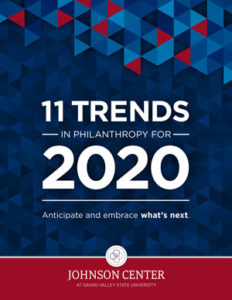Collaboration and Consolidation in Philanthropy’s Infrastructure


 A desire for greater impact and partnership is driving more of philanthropy’s infrastructure organizations to combine their efforts — and sometimes their staff. However, research suggests another possible motive for these changes: a lack of sustainable, significant funding for the work. Behrens and Martin explore further in this piece from our 2020 Trends report.
A desire for greater impact and partnership is driving more of philanthropy’s infrastructure organizations to combine their efforts — and sometimes their staff. However, research suggests another possible motive for these changes: a lack of sustainable, significant funding for the work. Behrens and Martin explore further in this piece from our 2020 Trends report.
Download and read the entire report, featuring all 11 trends, here.
Over the past several years, we’ve seen an increase in philanthropic infrastructure groups coming together to collaborate and consolidate. There are both benefits and potential pitfalls in the shifting landscape of the philanthropic infrastructure.
On the consolidation side, the 2019 merger of Foundation Center and GuideStar — longtime giants in the landscape of philanthropy’s infrastructure — into one entity, Candid, was a major development in the field. It is a marquis example, but it is not unique. At the local level, for instance, the Mississippi Center for Nonprofits and the Mississippi Association of Grantmakers also merged in 2019 to become one unified organization — the Mississippi Alliance of Nonprofits and Philanthropy.
Evidence of collaboration is also abundant. For instance, in 2017, the Forum of Regional Associations of Grantmakers concluded a two-year visioning process and unveiled a new name and mission — the United Philanthropy Forum aims “to be the place where philanthropy’s infrastructure comes together, integrating regional [Philanthropy Serving Organizations’] deep regional roots and connections with national PSOs’ deep content knowledge and reach in a more comprehensive and strategic way” (United Philanthropy Forum, 2017, para. 3).
In a similar vein, Joint Affinity Groups is now CHANGE Philanthropy. Through CHANGE, organizations like EPIP, ABFE, and AAPIP come together biennially for a joint Unity Summit. Their emphasis is on collaboration and urgency.
Funding constraints are clearly a factor in this trend. The Foundation Center’s 2018 report, U.S. Foundation Funding for Nonprofit and Philanthropic Infrastructure, 2004–2015, noted that in the full twelve-year period studied, infrastructure funding amounted to less than 1% of all foundation giving (0.71%).
An earlier report from the Foundation Center (2015) highlighted that, from 2004–2012, 881 funders awarded infrastructure grants to 511 nonprofits. However, 35 organizations, or just under 7% of all infrastructure organizations that received grants in that timeframe, received 48% of all infrastructure funding. The top four recipients — Foundation Center, the Bridgespan Group, Independent Sector, and the Council on Foundations — each received an average of more than $5 million a year.
“[T]he desire to forge stronger, more balanced relationships between funders and nonprofits is also a driver of this trend toward collaboration and consolidation.”
In total, the number of organizations receiving infrastructure support declined from a high of 328 in 2011, to 287 in 2015 (Foundation Center, 2018). Less than a year later, 22 infrastructure organizations issued a joint appeal, Investing in Infrastructure, inviting funders to dedicate at least 1% of their grantmaking to infrastructure support (National Council of Nonprofits, 2016). That would represent a small but substantial increase over 2015 levels.
On a positive note, the desire to forge stronger, more balanced relationships between funders and nonprofits is also a driver of this trend toward collaboration and consolidation. As the Worldwide Initiatives for Grantmaker Support (WINGS, 2017) notes in a report,
The combination of complementary strengths is a means to increase the effectiveness of an intervention…Building strong partnerships and collaborating are therefore important for philanthropy infrastructure organizations to develop the field and strengthen the sector. It is also one of the things that funders identified as key where they felt there was room for improvement. (p. 43)
Significantly, the numbers also illustrate that foundations are generally more inclined to support infrastructure organizations that explicitly serve foundations than those that serve nonprofits or are multi-sectoral: support for multi-sector infrastructure organizations represented only 9.5% of 2013–2015 grants, as compared to 36.9% for organizations serving foundations (e.g., regional associations and affinity groups).
“[T]he numbers also illustrate that foundations are generally more inclined to support infrastructure organizations that explicitly serve foundations than those that serve nonprofits or are multi-sectoral.”
Calls for greater investment in philanthropy’s infrastructure continue to appear, however. In 2018, Alliance Magazine and WINGS launched the #LiftUpPhilanthropy movement to encourage greater investment — and attention — from funders. “There are some encouraging signs,” writes Benjamin Bellegy (2018), executive director of WINGS, “that a growing number of funders, including individual philanthropists from emerging market economies, but also non-philanthropic funders such as development aid agencies, are strengthening their investments in this field” (para. 6).
In the 2017 WINGS report, 65% of respondents shared that “Staffing Size (Understaffed)” is a challenge for their organization. Forty percent identified “Staffing: Procurement of Knowledgeable Talent” as a challenge, as well. Serving an understaffed and under-resourced sector, philanthropy’s infrastructure is already working with less than what it needs to serve the field optimally. As we’ve noted in the past,
Concentration and consolidation can often lead to greater efficiencies and bigger impact when those who were pulling separately now pull together…But alternatively, it can also mean that there are fewer resources and thinkers available to do complex work. Our field can benefit from remembering that consolidation should happen when and because it advances the work (Behrens, 2019, para. 5).


Behrens, T. (2019, February 19). Notes on Candid: The merger of Foundation Center and GuideStar [Blog post]. Retrieved from https://johnsoncenter.org/notes-on-candid
Bellegy, B. (2018, May 18). Heads together to #LiftUpPhilanthropy. Alliance Magazine. 23(1), 37–42. Retrieved from https://www.alliancemagazine.org/feature/heads-together-liftupphilanthropy
Foundation Center. (2015, March). Foundation giving for nonprofit and philanthropic infrastructure 2004–2012. Retrieved from http://foundationcenter.org/gainknowledge/research/pdf/foundation_giving_nonprofit_philanthropic_infrastructure.pdf
Foundation Center. (2018). U.S. foundation funding for nonprofit and philanthropic infrastructure, 2004–2015. Retrieved from https://infrastructure.foundationcenter.org
National Council of Nonprofits. (2016, May 13). Investing in infrastructure. Retrieved from https://www.councilofnonprofits.org/tools-resources/investing-infrastructure
United Philanthropy Forum. (2017, July 24). With new name & vision, United Philanthropy Forum leads a new network to advance philanthropy. Retrieved from https://www.unitedphilforum.org/news/new-name-vision-united-philanthropy-forum-leads-new-network-advance-philanthropy
WINGS. (2017, February). A new global picture of organizations serving philanthropy. Retrieved from http://wings.issuelab.org/resources/26486/26486.pdf